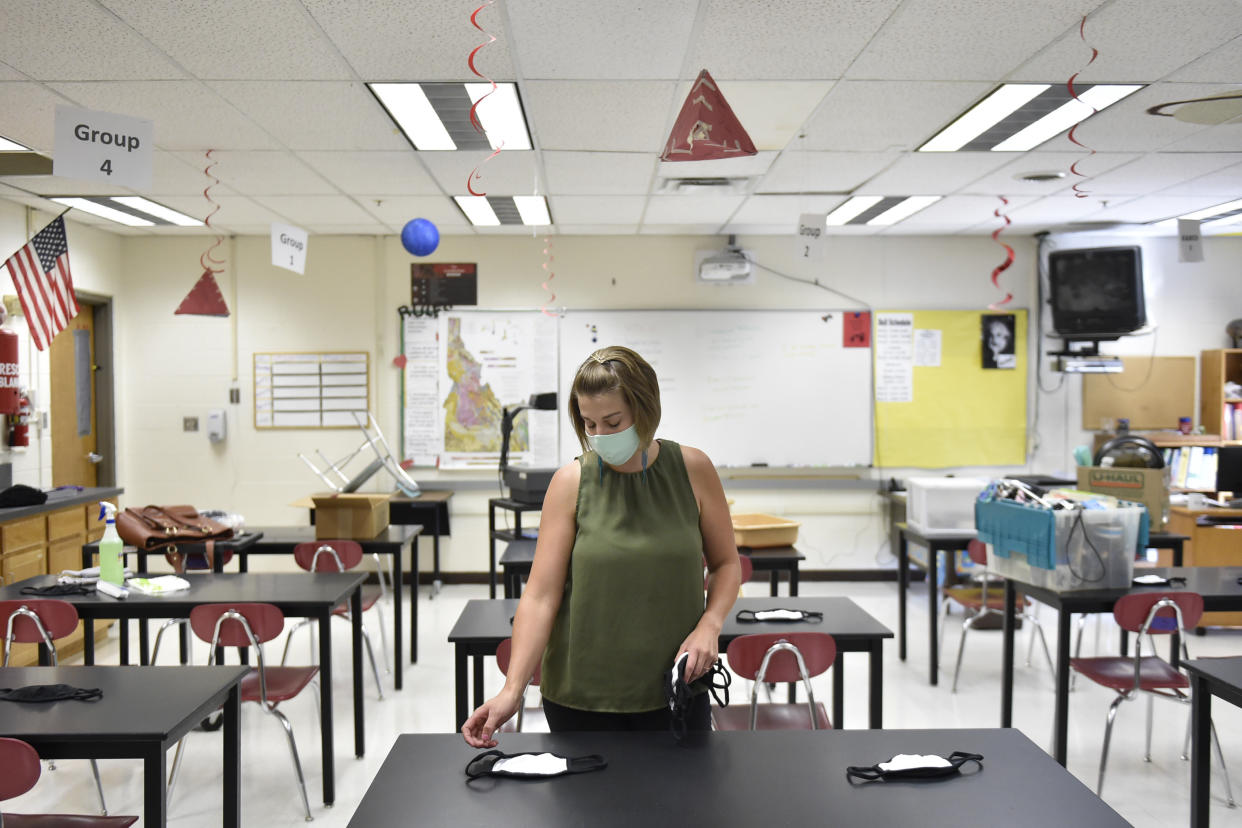Teachers, deemed 'essential workers' by White House, now likely to have to keep working after COVID exposure: 'Risks lives,' says union

For America’s teachers, back-to-school season has been a whirlwind of learning new safety protocols and adjusting existing teaching structures — either for in-person learning or continued online classes. But for educators in states where in-person classes are moving forward, a new mandate from the White House is likely making the new school year seem even more daunting.
Teachers, as Vice President Mike Pence informed state governors earlier this week, will now be classified as “essential workers,” meaning they will be subject to guidelines under the Centers for Disease Control and Prevention’s “critical infrastructure” workforce. Previously a designation used for doctors, first responders and law enforcement, the distinction includes guidance that suggests those who are directly exposed to the coronavirus can still work, as long as they don’t have symptoms.
“To ensure continuity of operations of essential functions, CDC advises that critical infrastructure workers may be permitted to continue work following potential exposure to COVID-19, provided they remain asymptomatic and additional precautions are implemented to protect them and the community,” the CDC’s guidance reads.
Related: Pence declares teachers are essential workers
During a telebriefing with reporters on Friday, CDC Director Robert Redfield was asked whether the organization expected teachers to return to the classroom after being exposed to the coronavirus. Redfield replied that decisions would “have to be worked out on a school-by-school, local-community-by-local-community” basis. He drew a parallel to being a physician, a vocation in which individuals have had to “stay in the arena” — implying that teachers may need to do the same as well.
“I would also just underscore how important our teachers are. I mean, their vocation is extremely important,” Redfield told reporters, adding later that he wanted to “congratulate and thank” them. “You know they didn’t need to be formally recognized as critical infrastructure workers, because I think we all know they are.” He noted that in order for schools to continue to operate, they will need the “confidence of teachers that it’s safe for them to go back and do their job” without getting sick.

But that confidence, especially in light of the new regulations, may not be there. Teachers in multiple states have gone viral for penning their own wills and protesting inadequate reopening plans, while others have begun crowdfunding for personal protective equipment. In a statement to Yahoo Life, a spokesperson from the National Education Association, a major teachers’ union, criticized the decision.
“If the Trump administration truly valued educators, it would have listened to their concerns months ago about safety and it wouldn’t be blocking another desperately needed coronavirus relief package that could provide schools with what they need to safely and equitably continue educating students during this pandemic,” the NEA said. “Instead, this administration is trying to extort educators into a [reckless] reopening that risks lives.”
Randi Weingarten, labor leader and president of the American Federation of Teachers, echoed the NEA. “Teachers are and always have been essential workers — but not essential enough, it seems, for the Trump administration to commit the resources necessary to keep them safe in the classroom,” Weingarten told Yahoo Life in a statement. “Rather than fund these protections, formulate a plan and issue guidance to ensure school buildings can reopen safely and follow the science, it changes the rules to threaten, bully and coerce.”
The White House did not respond to a request for comment from Yahoo Life on the new distinction, or on allegations that it was politically motivated. But even some in the medical world are worried that the classification was made hastily. Infectious disease expert Dr. Amesh Adalja, senior scholar at the Johns Hopkins Center for Health Security, is particularly concerned about the availability of PPE.
“If you declared them essential workers, you have to make sure that they’re treated like essential workers and have the appropriate personal protective equipment,” Adalja tells Yahoo Life. “Also that the facilities that they’re working in are able to limit the risk — just like essential workers in a hospital.” Adalja says that, as a health care provider, he is exposed to COVID-19 often, but still feels safe working.
“I continue to work, and that’s because I have personal protective equipment and there’s social distancing that’s available in the facilities that I work in,” says Adalja. “So you have to replicate that type of atmosphere.” In terms of what teachers need to remain safe, he mentions the same protections. “I think having a face covering with eye protection, that is important,” he says, “as well as hand sanitizer and a socially distanced classroom. Those are protections I would expect the teachers to have.”
One benefit for teachers of being declared essential workers, Adalja notes, is that they will be “considered a priority” for a vaccine once it is approved. But until then, hoping things go well isn’t enough. “This isn’t going to disappear. This is the new normal,” says Adalja. “So we need to find a solution that teachers are comfortable with because we’re going to be facing this for a prolonged period of time.”
For the latest coronavirus news and updates, follow along at https://news.yahoo.com/coronavirus. According to experts, people over 60 and those who are immunocompromised continue to be the most at risk. If you have questions, please reference the CDC’s and WHO’s resource guides.
How to maintain your physical and mental health during the pandemic
Taking care of a loved one with COVID-19? Here’s how to stay healthy
Q&A with Dr. Kavita Patel: How to keep your family safe and maintain your mental health
Read more from Yahoo Life
Want daily lifestyle and wellness news delivered to your inbox? Sign up here for Yahoo Life’s newsletter.


